Mention the words “fall foliage” and New England immediately comes to mind. Indeed, the traditional leaf peeping in the United States has always been focused on Vermont, New Hampshire and Maine. For those traditionalists wanting that New England fall foliage experience, the peak starts just about now in the more northerly regions of Vermont, New Hampshire and Maine. Then it moves in three directions — south, down slope and down east.
But my suggestion: You should move a lot further south, west, and yes, even north for some unexpected, and brilliant fall colors. Here are recommendations for great fall foliage in some surprising locations.
-from Peter Greenberg of Today
5 Unusual Destinations To View Fall Colors…
1. Michigan, Upper Peninsula

Michigan has more than 100 different species of trees, such as oak, ash, birch, maple and sycamore. Leaves turn from mid- to late-September into October.
You can find many scenic trails — for biking or hiking — in the Upper Peninsula of Michigan on state and national forest and parklands, along former railroad beds, and also in cities. Taking one of the many hikes in the UP is a great way to see fall foliage. If you prefer rugged trails, you can try tackling the trails in Porcupine Mountains Wilderness State Park. Located in Copper Harbor, Brockway offers breathtaking views and a 9½-mile drive with views of Lake Superior and the thousands of acres of the Keweenaw. The peak is about 735 feet above Lake Superior, and here you can see the beautiful colorings of fall, when the hardwoods display red, yellow and orange hues. Porcupine Mountains Wilderness State Park was built in 1945 on Lake Superior, and the park is 60,000 acres.
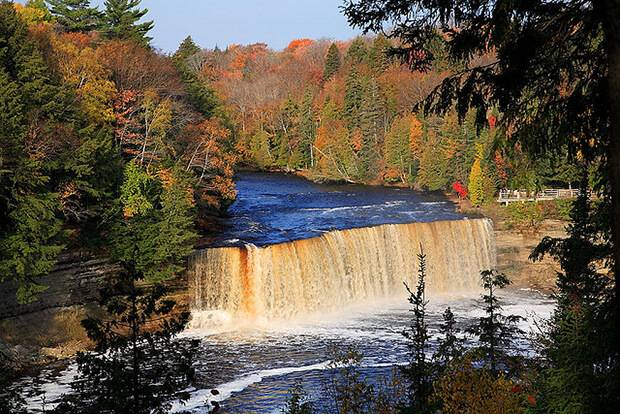
If you’re a mountain biker, you can reach some of the most remote areas of the park. Located in the park, the Kaug Wudjoo Lodge (pronounced kahg-WAD’-jiw) sleeps 12 and is available for weekly rentals. You also can rent one of their 19 rustic cabins or modern and rustic campsites. There are more than 11,000 inland lakes and 3,200 miles of Great Lakes shoreline in the state of Michigan. Wherever you stand in the Michigan, you’re within 85 miles of one of the Great Lakes. You are also no further than six miles away from an inland lake or stream. You should definitely take advantage of this waterway access, grab a canoe or kayak and enjoy some great — and uncrowded — fall foliage views.
Related Article: 12 of USA Cities For Fall Travel
2. Montana
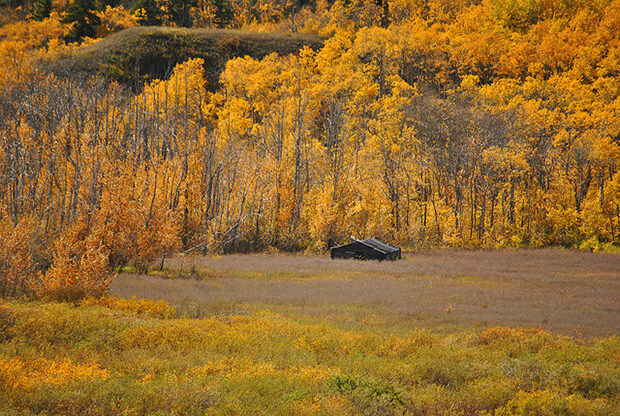
Dominant golden hues begin peaking in early October in Glacier National Park. The colorful trees include maples, larch and aspen. Maple trees usually dot hiking trails, and they turn to hues of yellow, orange and red. The larch and aspen trees turn to bright yellows and gold. These trees are normally near evergreens, so the foliage displays contrasting colors. The appearance of fall color varies, due to elevation. Late-September to mid-October is typically the best time to view fall foliage in Northwest Montana.
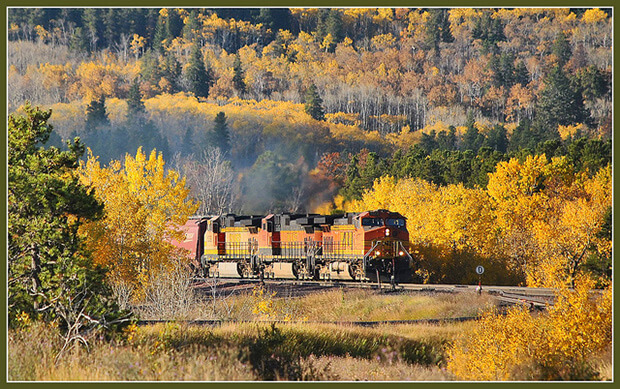
If you want great views of Glacier National Park or Flathead Valley and Lake, head to the summit of Big Mountain at Whitefish Mountain Resort. The Summit Trail is eight miles long and 7,000 feet high. Here, you will see golden hues of larch and aspen along with red hues from Montana’s huckleberry bushes And don’t forget Missoula — an almost forgotten fall foliage destination. Not only is it the cultural and outdoor mecca of Montana, there are numerous biking and hiking trails by the river.
Related Article: 12 Fantastic Fall Favorites for You to Visit
3. South Carolina
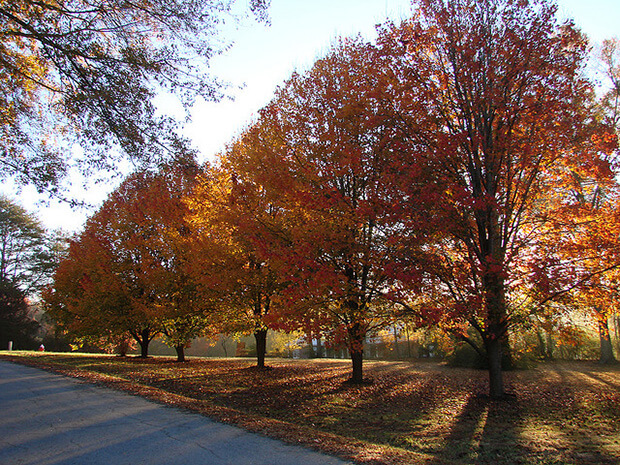
The fall color in South Carolina occurs in mid- to late-October in the mountains, and it occurs through mid-November in the Midlands. Head for the Cherokee Foothills National Scenic Highway (S.C. 11) — it’s about 115 miles long — and much of the highway runs along the escarpment and through South Carolina peach orchard country. Views include steep drops, deep mountain coves, waterfalls cascading hundreds of feet and broad vistas.
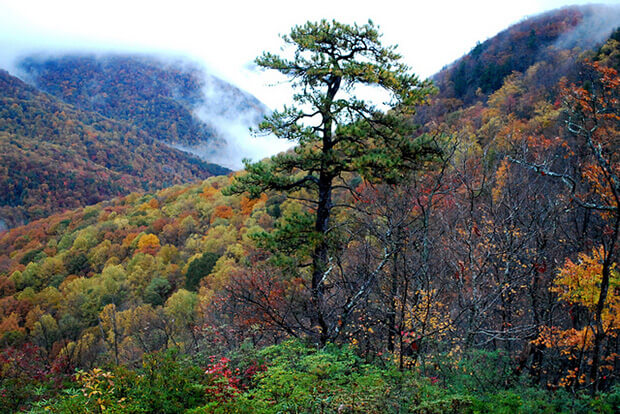
Caesars Head State Park is part of South Carolina’s Mountain Bridge Wilderness Area, and it also includes Jones Gap State Park. You can enter the park off the Cherokee Foothills highway, and it includes a five-mile drive through mountain valleys and coves where you can view small, pastoral farms and steep mountains. The park has a small river through a mountain cove where you can have great views of fall and enjoy trails that lead up the mountain to Caesars Head.
Related Article: 8 of the Best Trips To Have This Fall
4. Tennessee
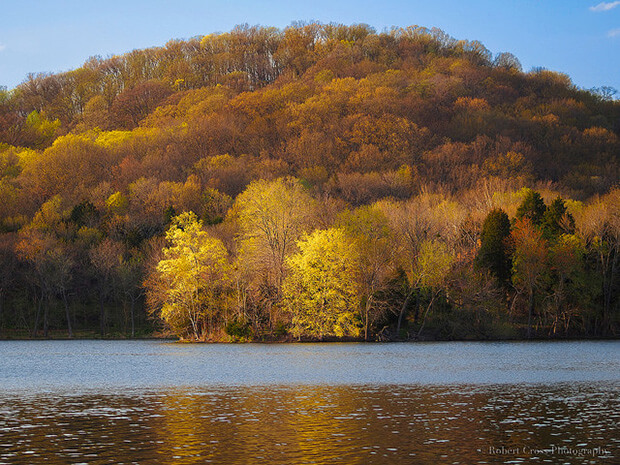
This is a true fall foliage state, but if you want guaranteed great fall colors, go to the Great Smoky Mountains National Park. This national park is the most visited in the entire country, and it receives 9 million annual visitors. In addition, Tennessee has nearly 400 festivals that celebrate fall, and it has 54 state parks and more than 1,800 miles of hiking and biking trails, so you have many opportunities to experience fall foliage. In East Tennessee, you will see the first sighting of autumn color. Trees above 3,500 feet change color first, usually during the first week in October. To see the best foliage, stay in East Tennessee for the second and third week of October, then go to middle Tennessee for later foliage sightings. The foliage in west Tennessee usually begins to change nearing the end of October to the first week in November. Tennessee has more than 400 species of deciduous trees.

By road, you can drive along the Cherohala Skyway and the Ocoee Scenic Byway. This is an especially popular time for motorcycles to drive along the skyway or byway. By rail, you can ride the Tennessee Valley Railroad on restored vintage trains in Chattanooga. In Knoxville, you can take the Three Rivers Rambler Train and explore east Tennessee. By boat, you can ride the Southern Belle Riverboat and enjoy lunch or dinner while viewing the fall foliage.
5. Utah
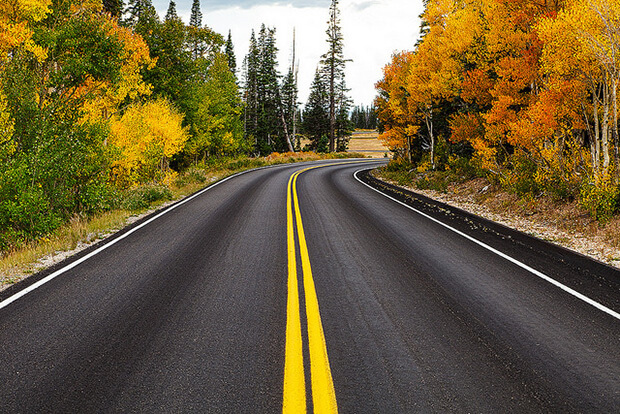
There are those who think that Colorado has a monopoly on the beautiful yellow leaves of the aspen trees each fall. But Southern Utah should not be overlooked. Places like Cedar City offer one of the most dramatic fall foliage backdrops in the country.

Cedar Breaks National Monument contains cliff faces eroded into the west side of the Markagunt Plateau. The rock layers a brightly colored rock strata and interesting formations. There are two main trails: Spectra Point/Ramparts Overlook is an easy two-mile hike that offers grand vistas along the cliff’s edge. Alpine Ponds Trail takes you through trees, meadows, flowers and wildlife for spectacular foliage viewing. You can also drive along the access road, UT 148, which circles the cliff’s edge. Leaves should start turning within the week. Kolob Canyon is located in Zion National Park. It offers breathtaking canyon views (some say it rivals the Grand Canyon in terms of the gorgeous colors and layers).
